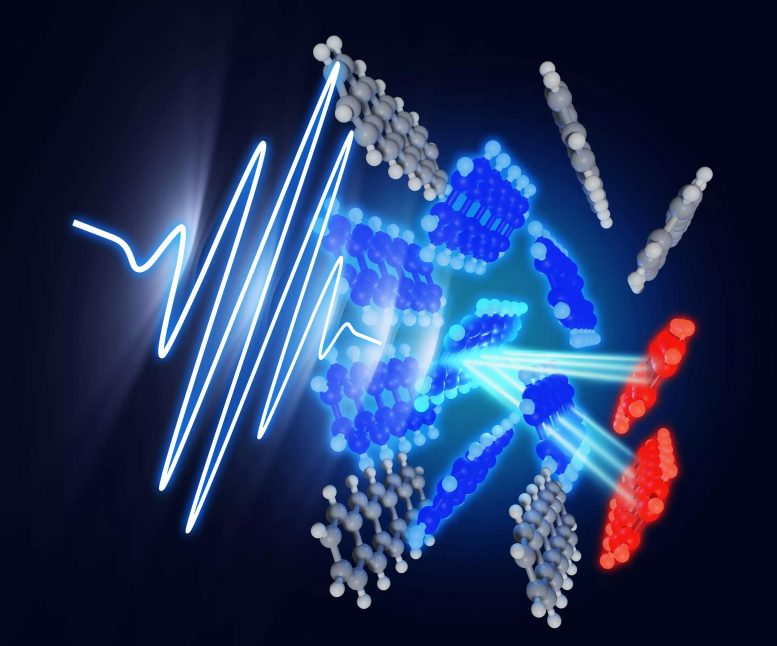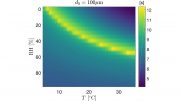
In the singlet exciton fission process, a singlet exciton (blue) is created upon absorbing light and then splits into two triplets (red) on ultrafast timescales. The team tracked the real-time molecular motions acompanying this process in single crystals of pentacene. Credit: © Jörg Harms, MPSD
Researchers from the Fritz Haber Institute (FHI) in Berlin, the MPSD and the Julius-Maximilians-Universität Würzburg have provided important new insights into a key process for the development of more efficient solar cells and other light-based technologies, called singlet exciton fission. They have managed to track how molecules of a promising material, single crystals comprised of pentacene molecules, move in real time as singlet fission takes place, showing that a collective motion of molecules may be the origin of the fast timescales connected to this process.
Energy generation in light-based technologies relies on the ability of materials to convert light into electrical power and vice versa. Certain organic molecular solids have the peculiar ability to significantly increase the solar to electrical power conversion efficiency, thanks to a process called singlet exciton fission (SEF). In this process two electron hole pairs, which are called excitons, are generated by the absorption of one light quantum (a photon). Because of the pronounced technological implications, tremendous research efforts have been dedicated to understanding how SEF really works.
The efficiency and speed of the SEF process are dictated by subtle details related to the way molecules arrange themselves in the material. Despite hundreds of studies on the topic, however, there had been no way to observe in real time how exactly the molecules move in order to facilitate the SEF event. Understanding this bit of the puzzle is essential to optimize SEF materials and further increase their efficiency.
In a study published in Sciences Advances recently, researchers from the FHI, the MPSD and the Julius-Maximilians-Universität Würzburg have managed to track how molecules in a crystalline material build from pentacene molecules move during the SEF process, using an experimental technique called “femtosecond electron diffraction.” Such a technique can capture snapshots of the atomic structure in real-time as the SEF process unfolds. In order to be able to capture these snapshots in pentacene, a material which only contains small and light atoms, the measurements had to reach an exceptional stability and resolution.
“We have brought such experiments to a point where they can treat these materials, which is very exciting for chemistry, biology, and materials science. These measurements have revealed that truly collective molecular motions accompany the SEF process in pentacene. Specifically, an ultrafast delocalized oscillation of pentacene molecules has been identified, which facilitates efficient energy and charge transfer across large distances,” says Heinrich Schwoerer from the MPSD.
Thanks to state-of-the-art theory, the team was able to reveal the molecular motions involved in the initial excitation event and how these motions trigger more complex molecular motions involving many molecules of the crystal. “Our theory analysis could resolve very complex molecular motions. We could identify a dominant one that involves molecules sliding with respect to each other, and that can only be triggered through the coupling of electronic excitations to other more localized molecular motions, that then, in turn, couple to this key motion also observed in experiment,” says Mariana Rossi from MPSD.
These collective atomic motions observed by the team involved in the project may well be the key to explain how the two excitons generated from the SEF process can separate, which is a prerequisite to harvest their charges in a solar energy device. “Simply put, our picture is that these molecular motions efficiently neutralize the forces that keep the two excitons together right after they have been generated, providing a possible explanation about the origin of the ultrafast timescales related to the fission, and thereby facilitate the high efficiency of solar to electrical energy conversion,” says Hélène Seiler, a postdoctoral fellow at the FHI in the group of Ralph Ernstorfer.
According to Sebastian Hammer of the chair Experimental Physics VI at the University of Würzburg, the team’s work will have a wider impact: “Beyond providing important insights into the SEF process, this work shows that it is possible to reveal the atomic motion in more complex, functional organic materials, which are delicate and composed of light atoms.”
Reference: “Nuclear dynamics of singlet exciton fission in pentacene single crystals” by Hélène Seiler, Marcin Krynski, Daniela Zahn, Sebastian Hammer, Yoav William Windsor, Thomas Vasileiadis, Jens Pflaum, Ralph Ernstorfer, Mariana Rossi and Heinrich Schwoerer, 25 June 2021, Science Advances.
DOI: 10.1126/sciadv.abg0869









Be the first to comment on "Singlet Exciton Fission: Breakthrough for More Efficient Solar Cells and Light-Based Technologies"